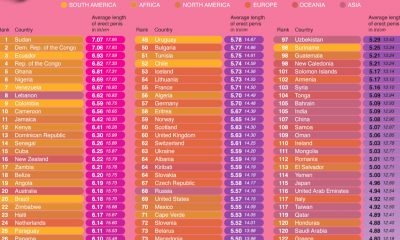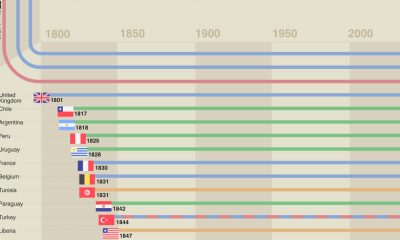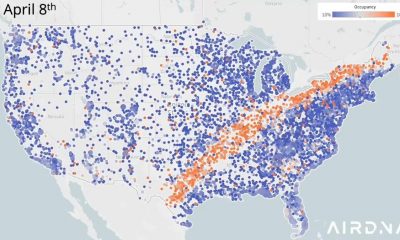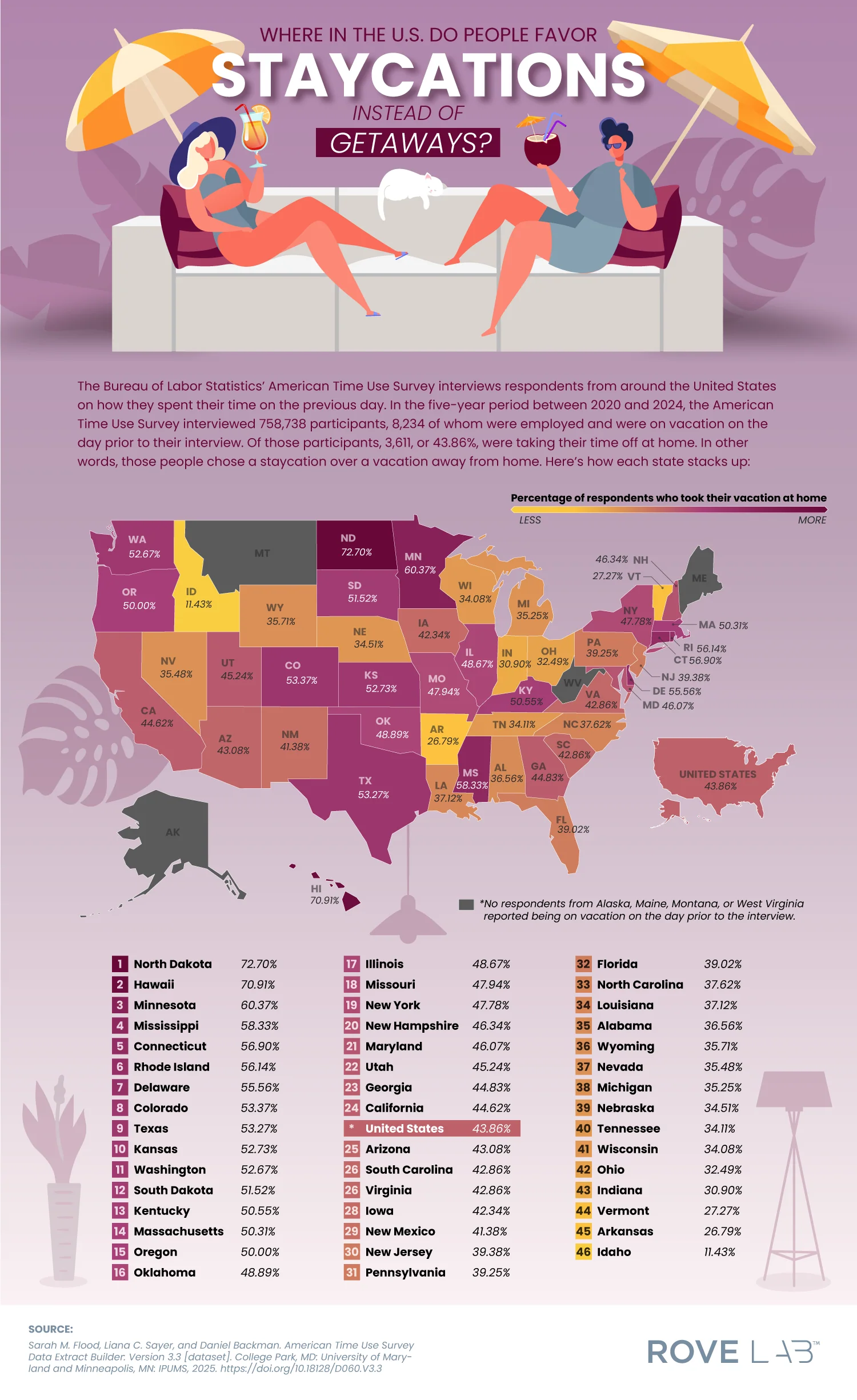Maps
Study Reveals the Most Sexually Adventurous States in America
Ever wondered which states are the most daring behind closed doors? A recent Too Timid survey of 1,427 Americans sheds light on the most sexually adventurous states in the U.S. The study ranked states based on four key factors: the average number of sex toys owned, sexual partners, sexual experiences, and fantasies that turn people on.
Click below to zoom.
Here are the top 10 most adventurous states:
- Montana
- Iowa
- Oklahoma
- Arkansas
- Minnesota
- New Jersey
- Oregon
- Nevada
- Alaska
- Indiana
Meanwhile, the least adventurous states include Rhode Island, North Dakota, Maine, and South Dakota.
Beyond state rankings, the study uncovered some intriguing trends in American bedrooms. The most common sexual experience is watching porn with a partner, followed by one-night stands. When it comes to fantasies, most people keep it simple, dreaming about sex with their current partner and enjoying some steamy dirty talk.
The Too Timid team highlights the positive effects of sexual openness, noting that people who embrace their sexuality often report better body image, stronger relationships, and more satisfying sex lives.
While this survey offers a fascinating glimpse into America’s intimate habits, more data and future studies could reveal even more surprising trends. Whether your state made the top ten or not, one thing’s clear—America’s curiosity about sex is alive and well!
Charts
Ranking the Best U.S. Cities for Pet-Friendly Vacations
Many Americans are devoted to their pets and consider their furry friends a part of the family. That means they want to include them in travel plans and vacations. A pet sitter or pet boarding can be pricey, plus pet parents will miss their pet companions while they’re away. The team at FloridaRentals.com created a valuable map for traveling pet owners, ranking U.S. cities by pet friendliness.
Click below to zoom.
The team considered several crucial factors when creating the ranking’s scoring system. Here are the factors considered:
- Percentage of pet-friendly hotels
- Average price of pet-friendly hotels
- Number of dog-friendly restaurants
- Dog park quality score
- Best cities to walk your dog score
- Pet health score
- Average review score of pet-friendly hotels
- Number of dog-friendly activities
- Dog parks per 100,000 residents
- Dog climate score
- Number of 24-hour vets
- WalletHub’s most pet-friendly cities score
All of these factors combine to help pet owners decide whether a city offers what they need. Many pet owners feel that the number, quality, and cost of pet-friendly hotels and restaurants are the most important factors. In contrast, others want to know they can have fun with their dog while vacationing with decent weather and plenty of walking trails and parks to explore. Others might put safety first and consider the presence of plenty of vet clinics to be most important.
After all scores were considered, a handful of cities rose above the others with the highest scores in the nation. Here are the ten cities with the highest scores:
- Portland, Oregon
- Albuquerque, New Mexico
- Phoenix, Arizona
- San Francisco, California
- Tampa, Florida
- San Diego, California
- Austin, Texas
- New York, New York
- Tucson, Arizona
- Colorado Springs, Colorado
Portland earned the top spot with high scores in nearly every category. The city has an abundance of beautiful parks and walking trails, paired with a strong pet-friendly culture. Albuquerque and Phoenix earned their high ranking thanks to plenty of affordable pet-friendly hotels and restaurants, paired with ample outdoor space. San Francisco, Tampa, and San Diego are great destinations for travelers seeking warm weather, walkable cities, and plenty of restaurants that welcome pets. In fact, many cities in Florida scored well, likely due to the warm climate and tourist-heavy culture.
We can see that cold-weather cities scored lower, like Boston, Milwaukee, and Detroit. Though accommodation prices are higher there and there may be fewer dog parks, there are still plenty of dog-friendly activities to enjoy in these bustling cities, especially if you don’t mind the cold.
Overall, this map shows that pet-friendly travel is not only possible but also a lot of fun, with many options for destinations. A great pet-friendly stay will combine affordability with comfort, safety, and fun for both you and your furry friend. As pet travel booms, these cities might even expand the accommodation they already offer.
Business Visualizations
Ranking States by Workplace Cleanliness
The team at Stratus Building Solutions reveals which states have the cleanest and dirtiest workplaces in a new study. Cleanliness is often an overlooked but powerful influence on workers’ health, happiness, and productivity. People who work in an office spend many hours there and have a right to a clean, safe space to work, whether that’s at their desk, in the breakroom, or in the bathroom. The team’s study reveals that cleanliness depends on more than company policy and culture. It’s impacted by resources and state laws. While some states mandate rules that boost workers’ health and safety, other locations lack such protections and put workers at risk.
Click below to zoom.
The team created a scoring system based on some key criteria. First was the number of OSHA violations. OSHA is the Occupational Safety and Health Administration, which sets federal workplace safety standards, including sanitation standards. A state with a high number of OSHA sanitation violations is a clear sign of dirty workplaces. These violations could include unclean restrooms, inadequate waste disposal, or the presence of mold and bacteria. The team also examined the number of janitors per capita, population density, air pollution, and sick leave laws in each state.
The team found that these states were the cleanest with the highest scores:
- Nebraska
- Colorado
- North Dakota
- South Dakota
- Washington
- Missouri
- Montana
- Idaho
- Michigan
- New Mexico
The top scorers had low rates of OSHA violations, clean air, and high janitor-to-population ratios. State laws mandating sick leave also play a major role, as workers are more likely to stay home rather than bring germs to work.
These were the states that struggled the most with these standards:
- Tennessee
- North Carolina
- Mississippi
- Virginia
- Connecticut
- Oregon
- Nevada
- Rhode Island
- Alabama
- New Jersey
- Pennsylvania
Many of these states are on the dirty end of the spectrum, lacking paid sick leave. Tennessee, Mississippi, and North Carolina do not have laws on paid sick leave, which, when combined with the absence of handwashing stations and disinfecting services, makes the workplace a petri dish for germs. We also see heavily populated states like New York and New Jersey on the low end of the spectrum because more people means a greater challenge to clean up waste and keep germs at bay. High populations also mean bigger cities and more air pollution. We do see, however, that lower population density doesn’t necessarily mean cleaner workplaces, as Vermont was near the bottom of the list and has a small population.
Clean workplaces are healthy workplaces. Dust, germs, and air pollution lead to gastrointestinal and respiratory problems among workers. Simple precautions like regularly disinfecting surfaces, installing handwashing stations, and removing dust can boost the cleanliness of the office and the health of workers. Healthy workers mean better productivity and greater safety for all. Not only will a clean space improve worker experience, but OSHA violations can be very costly. The team’s study provides fascinating insights into what affects workplace cleanliness.
Maps
Study Reveals Top American Staycation Destinations
Many Americans find that staycations can be just as relaxing as a getaway vacation, but without the expense and hassle. For people who appreciate their home and community, a staycation is a perfect choice to recharge. The team at Rove Lab studied where staycations are the most popular and analyzed data to determine the ranking.
Click below to zoom.
Here are the top 10 places where staycations were most popular:
- North Dakota
- Hawaii
- Minnesota
- Mississippi
- Connecticut
- Rhode Island
- Delaware
- Colorado
- Texas
- Kansas
North Dakota comes first, and maybe that’s no surprise when 22 million visitors come to the state every year to explore national parks, world-class hiking, and other attractions. North Dakota is a peaceful, beautiful state where people can make the most out of a staycation. Hawaii comes in second place for similar reasons. Hawaii is a dream vacation destination for people all over the world. There’s no need to stray far when you can relax on some of the world’s best beaches in your own backyard. But there’s another factor to consider for Hawaiians. It’s an expensive state to travel in and out of. Most people need to fly to leave the islands, and that airfare is costly because of Hawaii’s isolated location.
There are many benefits to taking a staycation beyond saving money on transportation and lodging. A staycation offers the chance to sleep in, appreciate your community and home, and practice hobbies and self-care. You can also prioritize spending time with people you love and pets you can’t bring on vacation. There’s no need to pack, no reason to rush to the airport, and you can take a break that helps the environment by cutting the carbon emissions of travel.
There are so many benefits to taking a staycation. They reduce cortisol, the stress hormone, which is essential for our overall health and happiness. The only real benefit missing from a staycation is the mass of new opportunities. New experiences form new neural pathways in our brains, and that helps us see things from new perspectives, which can be a huge mood boost as well as enhancing problem-solving skills. There are ways to have new experiences on a staycation, too. You can refresh and redesign your living space for a new environment. You can treat your community like you’re a tourist there. Look for new places and experiences you’ve never had and indulge with excitement and an open mind.
Staycations remind us that we don’t have to run away to seek out rest. The best adventures can be quiet ones, like an afternoon drive to a new café or restaurant, a hike you’ve never been on, or enjoying the view from your own porch. It’s a call to reconnect with your own home and spend time exploring hidden gems in your local city. You can read, garden, or explore your surroundings. No matter what you choose, you’ll finish refreshed, and this Rove Lab study shows that many Americans have already experienced the benefits of a staycation.
-

 Business Visualizations1 year ago
Business Visualizations1 year agoEverything Owned by Apple
-

 Business Visualizations1 year ago
Business Visualizations1 year agoAmerica’s Most Valuable Companies Ranked by Profit per Employee
-

 Business Visualizations10 months ago
Business Visualizations10 months agoThe Biggest Fortune 500 Company in Every State
-

 Business Visualizations7 months ago
Business Visualizations7 months agoThe Biggest Employers by Industry
-

 Maps2 years ago
Maps2 years agoPenis Lengths Around the World
-

 Business Visualizations2 years ago
Business Visualizations2 years agoAll The Brands Owned By PepsiCo
-

 Timelines2 years ago
Timelines2 years agoA History of the Oldest Flags in the World
-

 Business Visualizations2 years ago
Business Visualizations2 years agoNew Animated Map Shows Airbnb’s Fully Booked Cities Along the 2024 Eclipse Path of Totality




